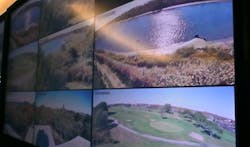FDNY Enhances Brush Fire Response with New AI System and Existing Cameras
Key Takeaways
- FDNY implemented an AI-driven system using cameras in city parks for early brush fire detection
- The AI-powered cameras are monitored from FDNY's command center in Brooklyn
- FDNY launched a Brush Fire Task Force following large fires in the fall of 2024 to coordinate prevention and mitigation efforts
After an unusually busy brush fire season in New York City last year, the FDNY tied an artificial intelligence-powered platform into an existing camera system at city parks for early notifications of brush fires.
A rash fires across the city in October and November 2024 - when the city saw historically low rainfall levels - saw then-newly appointed FDNY commissioner, Robert Tucker, create a FDNY Brush Fire Task Force which brought together various part of the fire department, from operations and fire prevention to assess New York City's readiness.
"When we recognized that problem, our commissioner sent a delegation out to Los Angeles January to see how they are fighting fires, and that was just coming on the heels of the two major fires they had out there," FDNY Chief Fire Marshal Daniel Flynn told Firehouse.com.
New York City has two brush fire seasons, usually spring and fall months when grass and brush are dry and there's little rainfall. They staff brush fire units during those peak times.
Learning from Los Angeles firefighters
The FDNY officers met with their counterparts in Los Angeles to learn more about all aspects of wildland fires, from prevention and mitigation to the utilization of technology, Flynn said. They looked at Los Angeles' wildland-specific PPE, fire apparatus, tactics, equipment, cause investigation and focused on how they have been using technology in all aspects of their response, from notifications to command.
"We spent a couple days there and when another fire came in while we were there, we were able to actually see them putt that into practice and see how they fought these fires," said Flynn.
"When we are at the Malibu fire, we saw these cameras that were installed to give them an early warning system and to let them know and that is actually how they found out about one of these fires," Flynn said. That piqued his interest and he began researching on his end to help stop the fires before they get out of control.
"I thought it would be interesting if we could find a high point and install these cameras and utilize it in the same way LA did," Flynn said. "Just to make sure we get these (firefighting) units out there as quickly as possible, this way we can put out a relatively small area of brush before it turns into large areas of brush (burning) that we experienced last October."
New York City parks now equipped with AI-powered cameras
Flynn said FDNY updated eight existing cameras in five locations across the city with the AI-powered platform.
"The cameras that we had, we were able to apply that technology in our camera. The infrastructure is cloud-based and complete with analytics. They're detecting smoking and fire," he said.
They are located with a higher viewpoint to monitor the tree lines for fires.
"In New York City, most of our parks are not a heavy life hazard," he said.
The cameras are powered by a built-in solar panel.
How the notification process works
If one of the department's cameras spots smoke or fire, it triggers a notification to the on-duty officer at FDNY's Command Center in the department's Brooklyn-based headquarters.
The officer would access the camera and size-up the situation to determine if it warrants a response.
If the officer says fire companies are needed, they contact the communications office who will dispatch resources based on conditions.
Flynn said the department responded to very few brush fires this fall due to heavy rainfall throughout the last two months
Cameras can help in fire investigations
Looking back on the trip to Los Angeles, Flynn said they also met with fire investigators from the Bureau of Alcohol, Tobacco and Firearms (ATF) who were assisting the Los Angeles firefighters with the investigation of the January Fire Storms.
"I knew some of those guys and we were able to link up with them and see how they actually investigate these fires because they're difficult from the fire investigative perspective," Flynn recalled. "It was such a large area and very few surveillance cameras in that area, so it's very interesting to talk to them and see how they conduct their investigations."
What's next?
Flynn said the department is continuing to investigate ways to update and enhance their brush fire monitoring systems.
They will continue to expand their Brush Fire Task Force, which includes investigations and even early mitigation efforts, plus the department's robotics unit, who operate drones during emergencies across New York City.
"We are always looking forward, looking to implement new technology that could be useful," said Flynn. "We want to be on top of the innovation and technology and anytime we see the opportunity to get better, we're going to take that opportunity and try to benefit from it."
About the Author
Peter Matthews
Editor-in-Chief/Conference Director
Peter Matthews is the conference director and editor-in-chief of Firehouse. He has worked at Firehouse since 1999, serving in various roles on both Firehouse Magazine and Firehouse.com staffs. He completed an internship with the Rochester, NY, Fire Department and served with fire departments in Rush, NY, and Laurel, MD, and was a lieutenant with the Glenwood Fire Company in Glenwood Landing, NY. Matthews served as photographer for the St. Paul, MN, Fire Department and currently is a photographer for the Fort Worth, TX, Fire Department.



